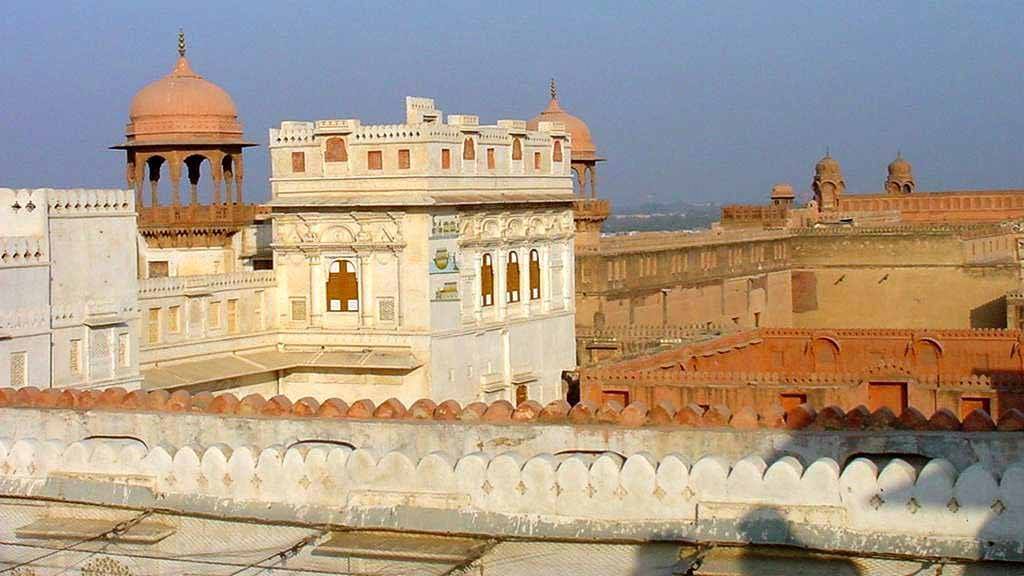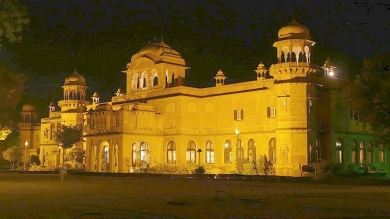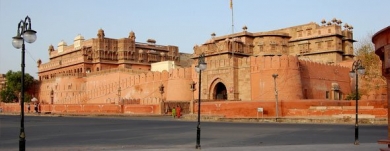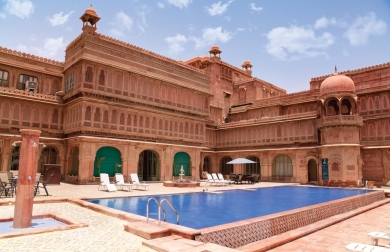Thar Desert open out to a magnificent heritage city of forts, palaces and markets, fortified against marauders by seven km long embattlements. This desert city called Bikaner, in Rajasthan, lies in the northern part of the Thar Desert and being a good source of sweet water became an important caravanserai for the merchants and traders who travelled with their camel trains from West and Central Asia to the kingdoms of East Asia.
Immensely wealthy, the desert kingdom of Bikaner was ruled over by a powerful dynasty that traced its lineage to the old ruling family of Jodhpur. But it was RaoBikaji who built the splendid havelis, forts and palaces in the city that bears his name. The ‘unspoiled’ ambience of well preserved medieval splendour and colourful bazaars make Bikaner a heritage city well worth visiting.
Some important questions arise when we choose a destination.
Most important places to Visit in Bikaner
Which all places I can visit along with Bikaner ?
Tour Itineries along with Bikaner
Best time to visit Bikaner
How to reach Bikaner?
Most important places to Visit in Bikaner
Junagarh Fort
The wonderful architectural piece was built between 1588 -1593 AD by Raja Rai Singh (1571 - 1611 AD) , a general in army of Mughal emperor, Akbar. The imposing fort has 986 long wall with 37 bastions and two entrances. The Suraj Pole (Sun Gate) is main entrance to the fort. The palaces within the fort are on the southern side and make a picturesque ensemble of courtyards, balconies, kiosks and windows.
Lallgarh Palace
The architectural masterpiece in red sandstone, built by Maharaja Ganga Singh (1881 AD-1942 AD) in memory of his father Maharaja Lall Singh between 1902 -1926.This magnificent palace is an example of pure Rajput martial architecture. Designed by Sir Swinton Jacob, this palace has several grand halls, lounges, cupolas and pavilions.The exotic palace has magnificent pillars, richly carved fire mantles, Italian colonnades and motif of lotus in full bloom, adding to the magic of this color full Palace.
Gajner Palace
Gajner Palace is a summer resort of Bikaner Maharajas and is often been described as an incomparable jewel in the Thardesert. Built by Maharaja Ganga Singh ji of Bikaner, palace stands on the embankment of a lake.
Karni Mata Temple (Rats temple)
Situated en route to Jodhpur, the temple is dedicated to Karni Mata -an incarnation of Durga. The temple has fascinating huge silver gates and marble carvings that were donated by Maharaja Ganga Singhji The most attractive feature of temple are the rodents who scamper freely within the premises and if one touches your feet its considered auspicious. They are regarded sacred and devotees buy prasad (feeding) to offer to them.TheKarni Mata Temple is dedicated to a 15th century local saint who is believed to be an incarnation of Goddess Durga.
Bhandeshwar and Sandeshwar Temples
Located on the outskirts of Bikaner, these 14th century temples are major tourist attraction in Bikaner.These temples are constructed by two brothers Bhandeshwar&Sandeshwar which were named after them. Bhandeshwar&Sandeshwar Temples are famous for their impressive carvings, astonishing wall paintings, admirable gold leaf paintings and rich mirror work.
Shiv Bari Temple
SShiv Bari Temple (6 kms from Bikaner) Fortified by a high wall the temple is dedicated to Lord Shiva. Maharaja Doongar Singh constructed it in the ninth century in the memory of his father MaharajLallSinghji. The temple has a beautiful wall panting of Nandi Bull facing the Shiva Lingam. This is located on the way to the camel town.The Shiv Bari Temple attracts the maximum number of visitors during the month of February. Besides, the temple is always crowded on Mondays when the local populace visit the temple.
Bhaironji Temple
Bhaironji Temple located at Kodamdesar near Bikaner in Rajasthan, India is definitely one of the most important places to see in this part of Rajasthan, India.
Ganga Singh Museum
This museum is popularly described as the best museum in the state, it displays a rich array of archaeological discoveries from prehistoric Harrapan and early Gupta period. Ganga Singh Museum is considered to be the best in Rajasthan for its treasure trove of artefacts from Harappan and Gupta periods. Paintings, terracotta, carpets, pottery, art and crafts, and Rajput weapons are on display.
Sun Gate
It is the main entrance to the fort. Among the notable of these palaces are the exquisitely beautiful Chandra Mahal or the Moon Palace with marvelous paintings, mirrors and carved marble panels, and the PhoolMahal or Flower Palace ornate with glass and mirror work. Other palaces worth visiting are the AnupMahal, Karan Mahal, DungarNiwas, Ganga Niwas, GajMandir and Rang Mahal, Gigantic columns, arches and graceful screens adorn the palaces from within.
Kalibangan
Nestled at 205-km away from Bikaner, Kalibanga, is located in Hanumangarh district of Rajasthan. Situated on the left bank of the Ghaggar (Ancient Saraswati) river, usually dry but occasionally flooded, at a distance of about 5 km from Pilibanga Railway Station, Kalibangan has equal Historical importance like Harappa and Mohenjo-daro. Saraswati was a part of the Indus River system. Historic ruins at Kalibangan can be seen as excursions from Bikaner that keeps high importance for the people who have interest in history. Kalibangan has cosmic historical importance as it was an important part of the ancient Indus Valley Civilization that flourished during 3000 B.C. to 5000 B.C.
ShriSadul Museum
ShriSadul Museum is located at Lalgarh Palace, the red sandstone palace located in Bikaner. It is housed in the Ganga Niwas, which covers the entire first floor of the palace. The museum displays a unique collection of miniature paintings, manuscripts, weaponry and old photos depicting royal hunts. It also houses the personal possessions of former Bikaner rulers, which includes golf tees, camera, clothes, books and earplugs. The museum is open daily from 10:00 to 17:00 hrs, except on Wednesdays. It can be visited on a small entrance fee. Photography is not allowed. ShriSadul Museum is about 3 km from Bikaner Junction Railway Station and 2 km north of downtown area.
The Rajasthan State Archives
The Rajasthan State Archives in Bikaner is one of the most worth visiting spots and is counted among the top Museums and Galleries in Rajasthan. It holds some very invaluable administrative records of Mughal Period such as Persian Farmans, Nishans, Manshurs, Akbarat, Vakil Report, Arzdasht and Khatoot. It also contains interesting records that were created during the administration of the Princely states of Rajasthan such as Bahiat, Pattas, Parwanas, Rukkas, Chithiat and so on.The Bikaner Rajasthan State Archives is obviously one of the very famous tourist spots for housing unmatched and truly priceless collection of records.
Katariasar Village
Situated approximately 45 km from Bikaner, on the Jaipur road, is the Katariasar village. The village provides a window into the ethnic rural and cultural life of Rajasthan. The village has a rich wildlife around it, consisting of Chinkara, Desert fox, Rabbit, Peacock, Parrot, Pat, etc. this village is also famous for its fire dancers, performing to the beat of drums on a bed of burning coals.
Devi Kund
Devi-kund, the Royal crematorium, is a world class example of architectural marvels of Historical India. Devi-kund is the site of royal cenotaphs (called Chattri in the local language) of the BikajiRathores, the great rulers of the Bika dynasty. Reflecting the Rajputana architectural style, the Devi-kundchattris steal the hearts of tourists.There are several chattris,EachChhatri is dedicated to the memory of rulers of Bikaji dynasty and is situated on the exact place where they were cremated. The Chhatri of MaharajSurat Singh is a fine example of architecture. The ceilings of the Chhatris displays some delicate Rajput paintings.
Gajner Wildlife Sanctuary
This reserve and the forested hills are 32 km from Bikaner on the Jaisalmer road, are inhabuted by wildfowl, hares , wild boar, desert foxes and a number of deer and antelopes including blackbucks and bluebulls. The lake at Gajner attracts water birds in thousands. Imperial sand gouse migrate here in winter. Gajner Wildlife Sanctuary, houses the former Hunting lodge of Bikaner and has a beautiful lake surrounded by a dense forest.
The Camel Breeding Farm
Bikaner-Camel Breeding Farm is one of the most preferred tours from Bikaner. The Camel Breeding Farm of Bikaner was founded by the Indian Council of Agricultural Research on July 1984. The Camel Breeding Farm is one of the largest camel farms of Asia and is located at Jorbeer, Bikaner.
Kolyatji
Kolyat is located 50 kilometres from Bikaner. It is a temple complex of Kolyat and a holy place of pilgrimage for Hindus. The legend has it that Kapil Muni the advocate of Shankya yoga of the Hindu philosophy while journeying towards northwest was struck by the tranquility and peace of this place and chose to perform tapasya (penance) here for the redemption of the world. This place has since acquired great sanctity. The complex has several temples, pavilions and bathing ghats. A dip in the holy waters of the lake especially on KartikPoornima (November) is considered very auspicious.
Tour Itineries along with Bikaner
Delhi - Mandawa - Bikaner - Jaisalmer - Jodhpur - Udaipur - Pushkar - Jaipur - Agra - Delhi
Delhi - Mandawa - Bikaner - Jaisalmer - Jodhpur – Ranakpur - Udaipur - Pushkar - Jaipur – FatehpurSikri - Agra - Delhi
Jaipur - Jodhpur- Pushkar - Jaisalmer - Bikaner - Udaipur - Mount Abu
Delhi - Mandawa - Bikaner - Jaisalmer - Jodhpur - Udaipur - Pushkar - Jaipur - Agra - Delhi
Delhi - Bikaner - Jaisalmer - Jodhpur - Pushkar - Jaipur - Agra - Jhansi - khajuraho - Varanasi – Delhi
Delhi - Samode - Nawalgarh - Mandawa - Bikaner - Jaisalmer - Jodhpur - Ghanerao - Ranakpur - Udaipur - Deogarh - Jaipur - Kanota - Agra – Delhi
Best time to visit Bikaner
The best time to visit Bikaner is from October to March when the weather is pleasant enough to explore the city and enjoy sightseeing.
The summer months, from March to June are extremely hot with the maximum temperature reaching up to 42 °C, while the minimum temperature falling up to 28 °C. Better not to visit this place during the summer season, when the extreme heat of the sun can lead to sunstroke.
During the monsoon season, from July to November, there is moderate downpour, but the atmosphere becomes humid.
How to reach Bikaner?
How to Reach Bikaner by Air
If you wish to fly in to Bikaner will have to use the nearest airport at Jodhpur (253 km). Taxis, tourist buses and state roadways buses available outside the airport provide transportation from Jodhpur to Bikaner - approximately 7 hrs driving time. You could rent a car or jeep through a reliable travel agent or tour operator.
How to Reach Bikaner by Rail
Bikaner is well connected to Delhi, Jaipur, Jodhpur, Allahabad (Uttar Pradesh), Bhatinda (Punjab), Kalka (Himachal Pradesh) and Calcutta (West Bengal) by regular train services in both fast and mail train categories after the Western Railway’s conversion to broad gauge rail.
How to Reach Bikaner by Bus
Bikaner is linked by good, all weather roads that are part of the state and national highways linking the major cities of north India like Delhi (458km), Jaipur (354 km), Jodhpur (249km) and Jaisalmer (333km). State Roadways and private bus owners operate air-conditioned and ordinary bus services from Bikaner to all parts of Rajasthan as well as to destinations in the neighbouring states of Delhi, Haryana and Punjab. Rented cars and jeeps and conducted tours are available from Delhi, Jaipur and Jodhpur for Bikaner.
Packages
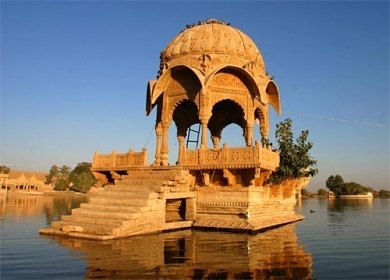
2 Nights Rajasthan - 3 Star - Rs.16700
Bikaner Packages
